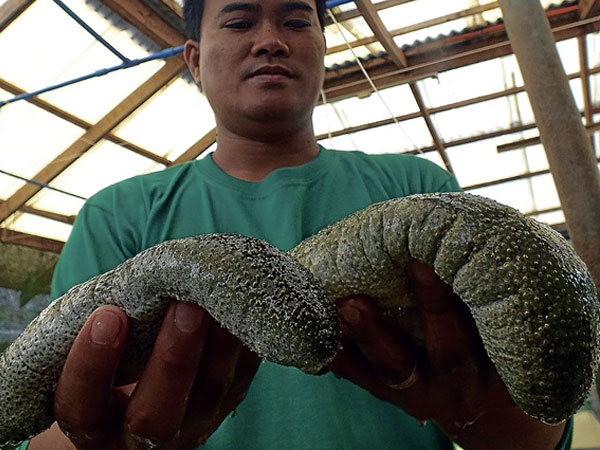
SEA CUCUMBERS are being bred and reproduced at the Bureau of Fisheries and Aquatic Resources center in Alaminos City. YOLANDA SOTELO/INQUIRER NORTHERN LUZON
ALAMINOS CITY – At the Bureau of Fisheries and Aquatic Resources’ (BFAR) demonstration center in this city, fishery specialists are moon watchers.
They observe lunar phases not because they are romantics, but because the moon’s appearance has a big influence on the reproductive abilities of fish they are propagating.
For instance, siganid (malaga) breeds during the first quarter of the moon, Rey Arthur Santillano, officer in charge of the Regional Mariculture Technology and Demonstration Center in Lucap village, said.
“There is also a courtship period of two days before fish spawn. Two days before the moon’s first quarter phase, we put a female and two male siganid in a 250-liter tank. The male fish secretes plenty of milt [sperm-containing secretions of fish] which is why we put two female fish so the milt won’t be wasted,” Santillano said.
Siganid is one of three species being propagated in the center. The others are abalone (Haliotis asinina), which reproduces during the full moon, and sand fish or sea cucumber, which breeds before and after the full moon.
But fishery technologists here do not depend solely on the moon to make fish spawn. They also induce reproduction through hormones (siganid), thermal shock (abalone) or feed them with microalgae like spirulina.
The BFAR facility used to propagate bangus (milkfish) but shifted this year to the three high-value species. The sabalo (mother bangus) has been transferred to the BFAR research center in Dagupan City.
“We have enough technologies on the production of bangus that is why we have shifted to other high-value species. We also want to preserve and propagate fish and invertebrates which are endangered because of overfishing,” said Remely Lachica, officer in charge of BFAR Ilocos’ planning, monitoring and evaluation division.
“If we do not conserve and produce these species, we will lose them in the long run because of the high extraction rate,” she said.
Even in a controlled environment, the chance of larvae survival is very low. For instance, from 560,000 larvae of abalone, only 8 percent or 44,800 survive after 70 days.
“So you see the need to push for the protection of these resources,” Lachica said.